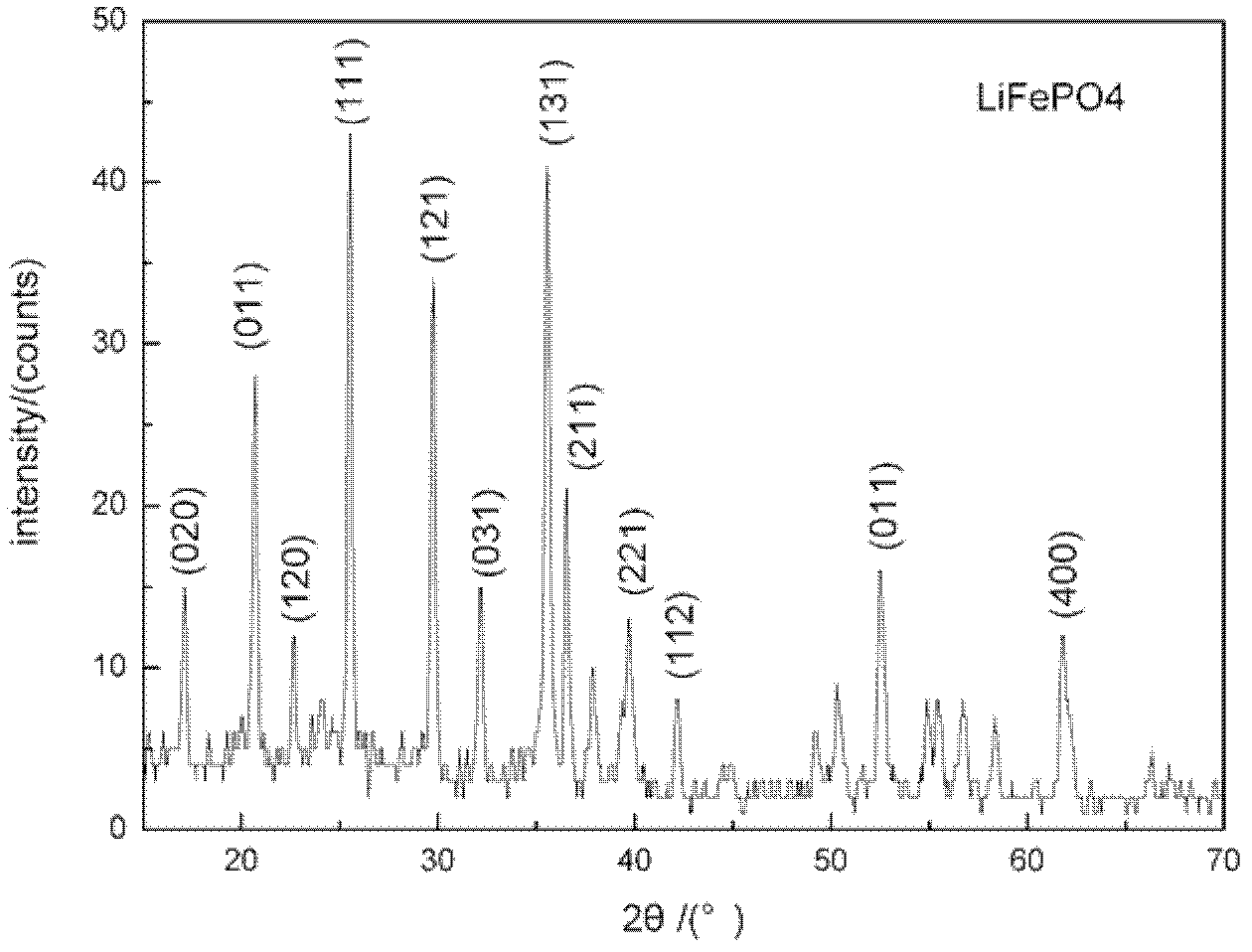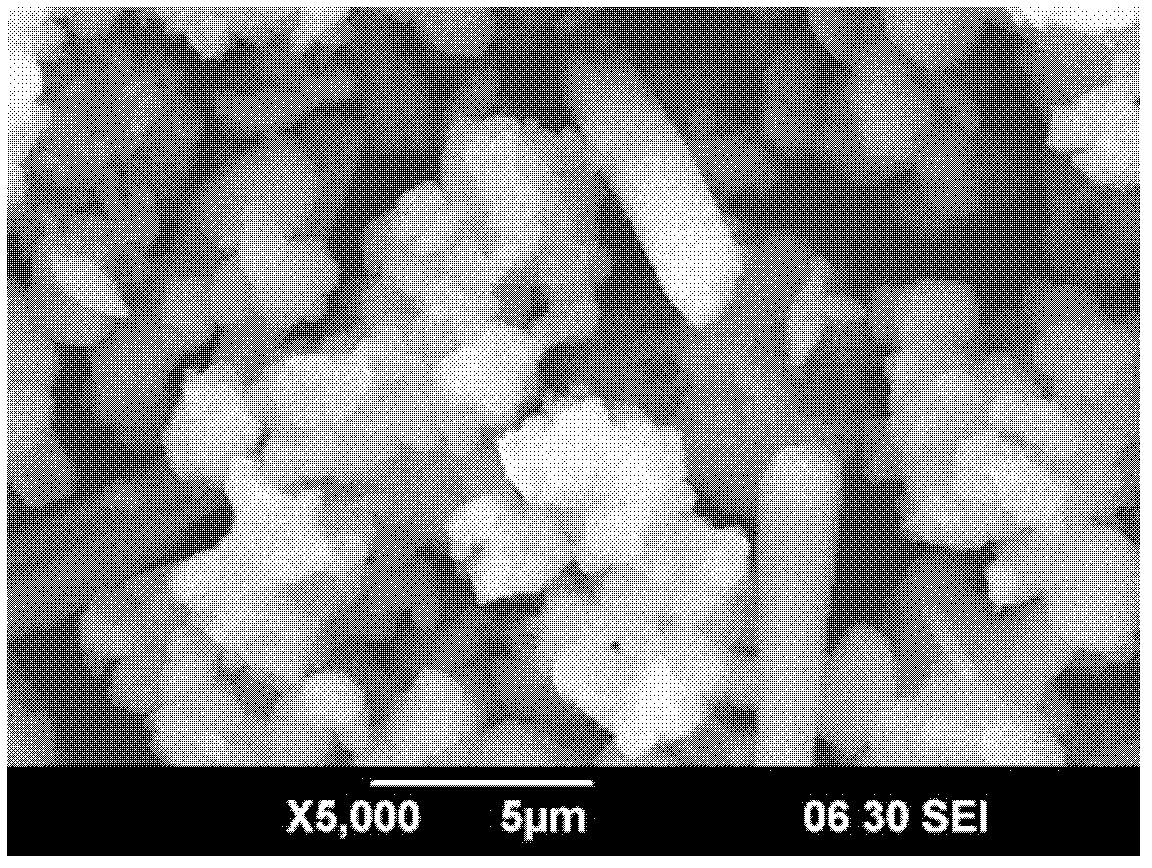Microwave hydrothermal synthesizing method for carbon nanotube/LiFePO4 lithium ion battery anode material
A lithium-ion battery, carbon nanotube technology, applied in battery electrodes, circuits, electrical components, etc., can solve the problems of low ion diffusion coefficient, poor cycle performance, low electrical conductivity, etc., and achieve high synthesis rate, less aggregation, Granular complete effect
- Summary
- Abstract
- Description
- Claims
- Application Information
AI Technical Summary
Problems solved by technology
Method used
Image
Examples
Embodiment 1
[0017] 1) Analytical pure LiOH·H 2 O and NH 4 h 2 PO 4 with FeC 2 o 4 2H 2 O according to Li:PO 4 : Fe = 3: 1: 1 molar ratio is added to deionized water, and after sealing, it is placed on a constant temperature heating magnetic stirrer and stirred to prepare Fe 2+Solution A with a concentration of 0.2mol / L;
[0018] 2) Press LiOH·H 2 O and FeC 2 o 4 2H 2 The mass ratio of O mass sum and citric acid is 1: 0.5 in solution A, add analytically pure citric acid (C 6 h 8 o 7 ·H 2 (0), magnetic stirring under normal temperature evenly obtains solution B;
[0019] 3) Disperse carbon nanotubes (CNTs) in concentrated HNO 3 immersion at 80°C for 10 hours, then ultrasonically cleaned for 5 hours in an ultrasonic cleaner with a water bath temperature of 40°C and an ultrasonic power of 300W, and then cleaned with deionized water and absolute ethanol to obtain purified CNTs;
[0020] 4) Add 0.2% of the purified CNT of solution B to solution B, and magnetically stir at room ...
Embodiment 2
[0025] 1) separate analytically pure Li 2 CO 3 and NH 4 h 2 PO 4 with FeC 2 o 4 2H 2 O according to Li:PO 4 : Fe = 1: 3: 0.5 molar ratio is added to deionized water, sealed and placed on a constant temperature heating magnetic stirrer to stir to prepare Fe 2+ Solution A with a concentration of 0.1mol / L;
[0026] 2) Press Li 2 CO 3 and FeC 2 o 4 2H 2 The sum of O mass and citric acid are 1: 1.5 mass ratios in solution A, add analytically pure citric acid (C 6 h 8 o 7 ·H 2 (0), magnetic stirring under normal temperature evenly obtains solution B;
[0027] 3) Disperse carbon nanotubes (CNTs) in concentrated HNO 3 immersion at 50°C for 15 hours, then ultrasonically cleaned for 3 hours in an ultrasonic cleaner with a water bath temperature of 50°C and an ultrasonic power of 100W, and then cleaned with deionized water and absolute ethanol to obtain purified CNTs;
[0028] 4) Add 3% of the purified CNT of solution B to solution B, and magnetically stir at room temp...
Embodiment 3
[0032] 1) Analytical pure LiOH·H 2 O and NH 4 h 2 PO 4 with FeC 2 o 4 2H 2 O according to Li:PO 4 : Fe = 0.5: 2: 2 molar ratio is added to deionized water, after sealing, it is placed on a constant temperature heating magnetic stirrer and stirred to prepare Fe 2+ Solution A with a concentration of 0.5mol / L;
[0033] 2) Press LiOH·H 2 O and FeC 2 o 4 2H 2 The sum of O mass and citric acid are 1: 2 mass ratios in solution A, add analytically pure citric acid (C 6 h 8 o 7 ·H 2 (0), magnetic stirring under normal temperature evenly obtains solution B;
[0034] 3) Disperse carbon nanotubes (CNTs) in concentrated HNO 3 immersion at 100°C for 5 hours, then ultrasonically cleaned for 1 hour in an ultrasonic cleaner with a water bath temperature of 60°C and an ultrasonic power of 400W, and then cleaned with deionized water and absolute ethanol to obtain purified CNTs;
[0035] 4) Add 8% of the purified CNT of solution B to solution B, and magnetically stir at room temp...
PUM
| Property | Measurement | Unit |
|---|---|---|
| electrical conductivity | aaaaa | aaaaa |
Abstract
Description
Claims
Application Information
 Login to View More
Login to View More - R&D
- Intellectual Property
- Life Sciences
- Materials
- Tech Scout
- Unparalleled Data Quality
- Higher Quality Content
- 60% Fewer Hallucinations
Browse by: Latest US Patents, China's latest patents, Technical Efficacy Thesaurus, Application Domain, Technology Topic, Popular Technical Reports.
© 2025 PatSnap. All rights reserved.Legal|Privacy policy|Modern Slavery Act Transparency Statement|Sitemap|About US| Contact US: help@patsnap.com


